Montanaro’s Rewilding Project
I recently flew from London to Dublin and as I gazed out of the window, I found myself struck by the manicured beauty of the English countryside. All I could see, for miles and miles between Britain’s towns and cities, were acres and acres of crops, grazing pastures, drained meadows, lines of fences and trimmed hedgerows, dry streams, unnaturally straightened rivers running in parallel to roads, woods of regimented spruce, slopes of broken heather and eroding peat, blocks of conifers grown for timber, and hills trodden bare by sheep and cattle. Here, from my carbon intensive vantage point, it struck me hard: there really are very few spots in our country that have been left untouched by human activity. This is having very real consequences on the health of our land and the bugs and creatures that rely on it. So Montanaro has decided to act: by helping to Rewild Britain.
Mention the term “rewilding” and many people will instinctively think of a plot of land that may look a bit messy and out of place, set within our ordered English countryside. Rewilding (whatever the Daily Mail says) is so much more than simply letting a field get a bit messy. It is a total reimagining of what we perceive our “green and pleasant land” (as William Blake so famously wrote) to be. Rewilding, done at scale, is the “restoration of ecosystems to the point where nature is allowed to take care of itself. Rewilding seeks to reinstate natural processes and, where appropriate, missing species – allowing them to shape the landscape and the habitats within. It’s focused firmly on the future although we can learn from the past”. This definition comes from Rewilding Britain, the first and only country-wide organisation in Britain focusing on rewilding and the benefits it can bring for people, nature and the climate.
We are delighted to announce that Montanaro is sponsoring this incredible organisation as it seeks to meet ambitious goals by 2030.
Additionally, we are providing funding to a unique and ground-breaking project run by the Dorset Wildlife Trust: the restoration of the River Sherford in Wild Woodbury. 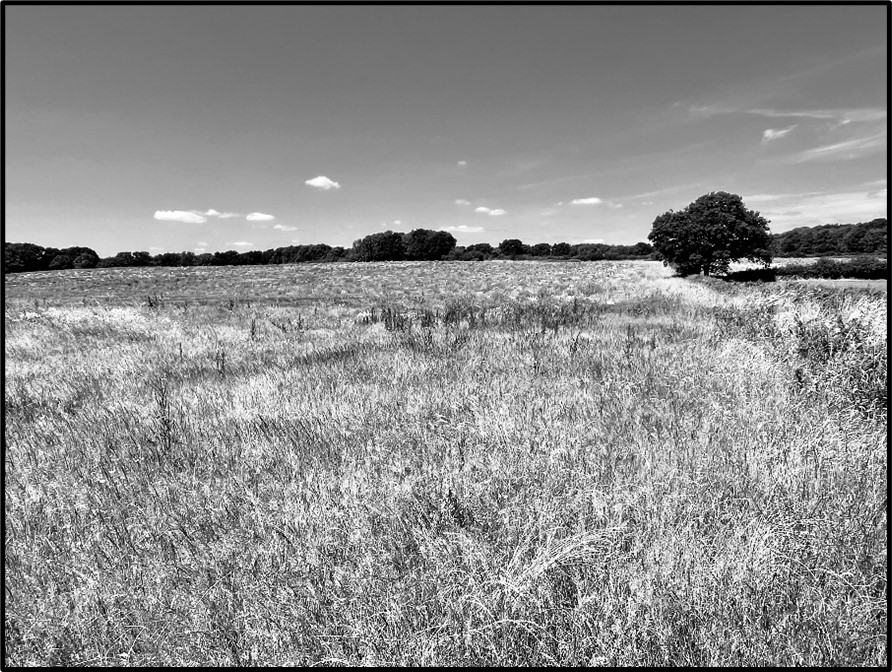
Rewilding Britain, alongside other stakeholders, is calling for 30% of land and sea across the UK to be restored for nature by 2030. Their vision is as follows:
- Create core rewilding areas across at least 5% of Britain: these will focus on restoring and reinstating as wide a range of natural processes, habitats and missing species as possible.
- Establish nature-enhancing land and marine uses across at least 25% of Britain: these will embed and connect core rewilding areas within a broader mosaic of land and marine uses, such as low-impact mixed forestry, harvesting of natural products, nature-based tourism and high-nature value grazing.
Our funding to Rewilding Britain will support its “Rewilding Network”, a network of rewilding projects across Britain that provides support, education and guidance to those undertaking rewilding projects[1].
The support we provide to the Dorset Wildlife Trust will help to restore the River Sherford in Wild Woodbury. This is a flagship rewilding project, not only for the Trust (it is their biggest ever large-scale rewilding project), but for the country too. Covering an area of 170 hectares of farmland, acquired by the Trust last year, the project aims to restore woodland and wetland habitats across the site, reducing high nitrate levels in the local waterways and preventing them from entering Poole Harbour, located at the river’s mouth.
From a national perspective, the Wild Woodbury project is unique: it is the country’s first community rewilding project and will provide opportunities for people of all backgrounds and abilities to play a key role in helping to create a new space for nature, including the Montanaro team. It aims to provide inspiration and guidance for further rewilding projects around the country.
Cedric and I took a trip to Dorset to see the site at the very beginning of its journey. Our guides were Brian Bleese, CEO of the Trust, and Rob Farrington, the extremely knowledgeable Project Manager. To say we were blown away would be an understatement. To explain why, let us start with a photo I took of one of the fields at Wild Woodbury:
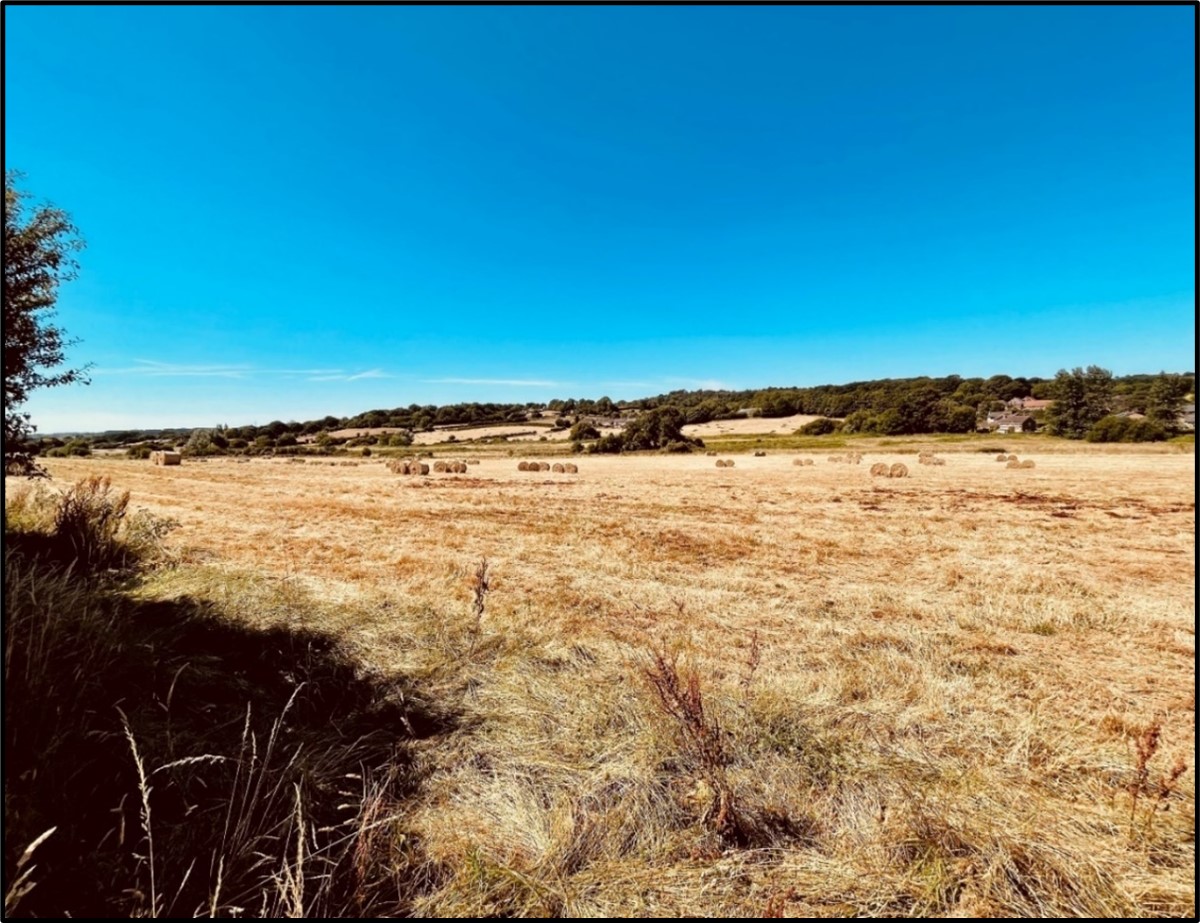
This picture is typical of a British field at this time of year: grass cut short, rolled into hay bales. It looks picturesque, the kind of field that makes me think of quintessential Britain: strawberries, bunting, village fairs, country pubs, a combine harvester humming away somewhere nearby. (This is the country boy in me speaking, I grew up just over the border in Wiltshire).
However, this is not a “natural” field. This is a cultivated and farmed piece of land. In isolation there is nothing wrong with this, but if you gaze into the distance, you can see that every field is largely the same. For wildlife, this is consequential.
As the rewilding pioneer Isabella Tree noted in Wilding: The Return of Nature to a British Farm, her excellent book on the pioneering rewilding project at the Knepp Estate, “we forget, in a world completely transformed by man, that what we’re looking at is not necessarily the environment wildlife prefer, but the depleted remnant that wildlife is having to cope with: what it has is not necessarily what it wants.”
So, we asked Rob: “what will this field look like when it has been rewilded?”. His answer was fascinating and took us on a journey over literally hundreds of years. To begin with, nature will take over and different species of native plants and flowers will emerge. Their type will change over time: spear thistles may flourish initially, before other native flowers, willowherb, fen violet, thyme, nightshade and others take over. The far side of the field will be dominated by trees and a diverse orchard, the fruit collected and provided to the local community. Children from a nearby school will soon plant oak trees, their acorns collected from the site and nurtured into small saplings in the classroom. These will be planted in a wide circle, an “oak henge”, to form a space for contemplation and peacefulness. They will grow and stand tall for the next 800 years. What a thought! What futuristic descendants will enjoy the shade provided by these trees?
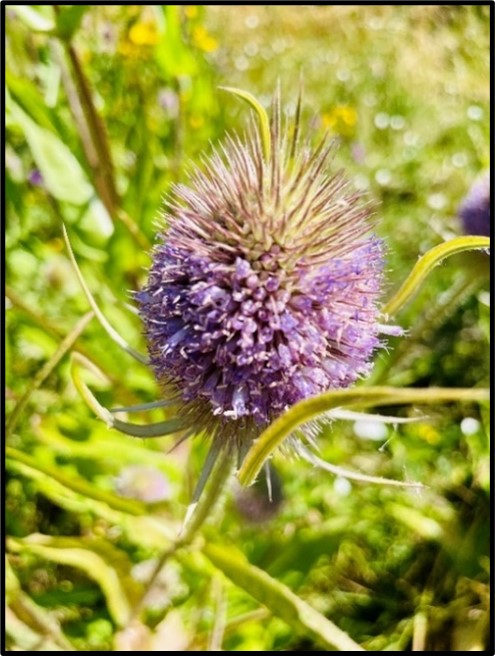
More immediately, the field will evolve into a community hub, allowing people to explore a rewilded landscape themselves. There will be no cut paths; instead, people will walk where nature suggests. In one corner of the field there will be a well-being space for people to sit, surrounded by nature.
There is a huge well-being element to rewilding. Several derelict and disused farm buildings stand at the entrance to the site. Some will be torn down due to asbestos; others repurposed. The building in the adjacent picture will become a welcome centre. There is also the desire to work with the local doctors’ surgery so that as well as practicing conventional medicine, the surgery can also recommend the healing power of nature. Patients may find that rather than being given a prescription, they are sent to sit beneath the oak trees for an hour or two.
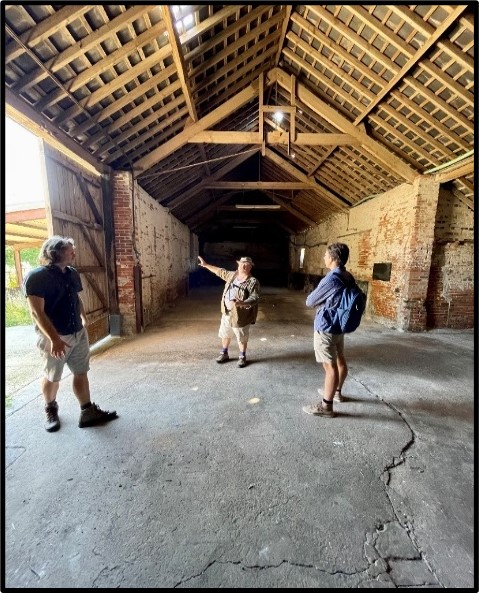
We walked far, seeing with our own eyes the first stages of rewilding taking place in other areas of the site. Everywhere, nature is being left to its own devices and the results are beautiful to witness, if you are able, for a moment, to forget the image of the English countryside that we are so used to. Thistles, wild grass and flowers flourish. The ground was covered with tiny ash trees. Rob even said that wild orchids were growing on the site. The most amazing butterflies were flying in the sun: the silver-washed fritillary and the small pearl-bordered fritillary to name but two. We even saw a deer prancing across one of the fields. Nettles stung our legs and ankles, but somehow this did not feel as irritating as normal. Bees and other insects were busy going about their work. At Wild Woodbury, Life’s (with a capital “L”) partnership with nature is being restored.
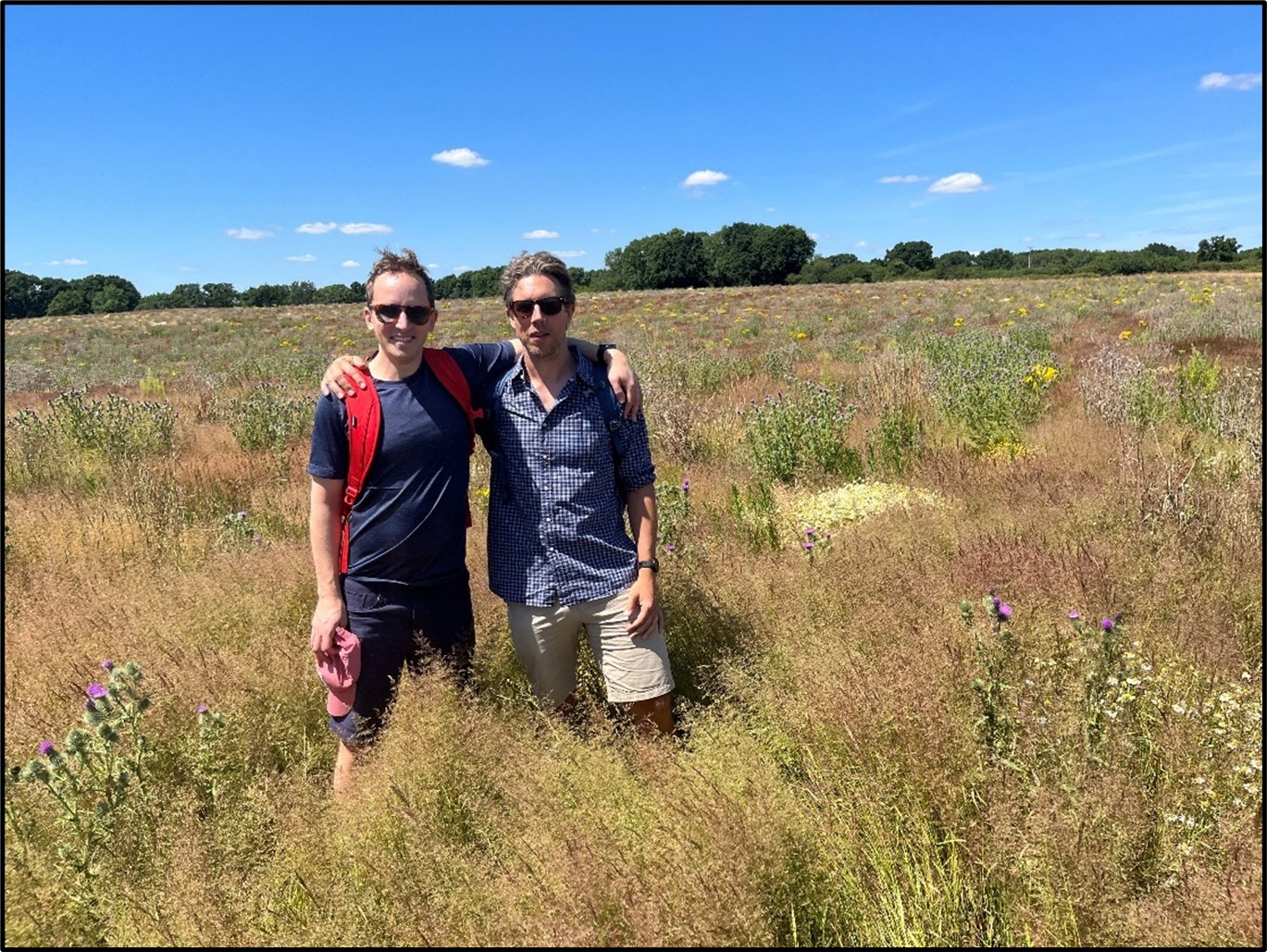
A major aspect of the site is a pioneering project that aims to restore the River Sherford, one of the four main rivers flowing into Poole Harbour. The river, like many others across the country, has been meddled with, straightened and deepened to remove water as quickly as possible from the land. As Rob and Brian explained, human interventions over many generations have been so complete that society has largely forgotten what a natural river looks like.
This has impacts across the course of a river: pollutants from the land and roads reach the sea quickly, causing a build-up of nutrients that are highly detrimental to wildlife; it leaves soils less able to store carbon; it leaves communities downstream in danger of flash flooding; and removes the chance for wildlife rich wetland habitats to develop.
Through Wild Woodbury, the Trust owns most of the headwaters of the river Sherford. This provides them with a unique opportunity to restore the headwaters of the river back to a more natural state, allowing the water to choose its own course which will change over time.
How is this going to occur – and how will Montanaro help, aside from our funding? After a long walk, we arrived at the edge of a small wood, where Rob showed us a dry ditch, hidden beneath some undergrowth. Given the lack of rainfall, there was no water in sight, but Rob explained that this human-made ditch needed to be dammed once the rain comes in the autumn. This will not be done by machines, but rather by human hands – or to be specific, members of the Montanaro team.
In October, a group of us will travel down to Dorset for one of our annual “Charity Days”. We will get muddy and probably quite wet as we build a natural dam of branches, twigs and other forest debris to stop the water flowing down this artificial channel. All being well, we will then watch in satisfaction as the water spills out and begins to create natural wetland.
The environmental impact of this project is potentially significant. It is forecast to create between 30 to 40 hectares of wetlands. Healthy wetlands store carbon and slow the flow of water, cleaning it naturally and reducing flood risk downstream. They support an abundance of plant life, which in turn provides perfect shelter, nurseries and breeding grounds for wildlife. The positive effects will be felt across the Wild Woodbury site, along the river’s course and by the marine life in Poole Harbour.
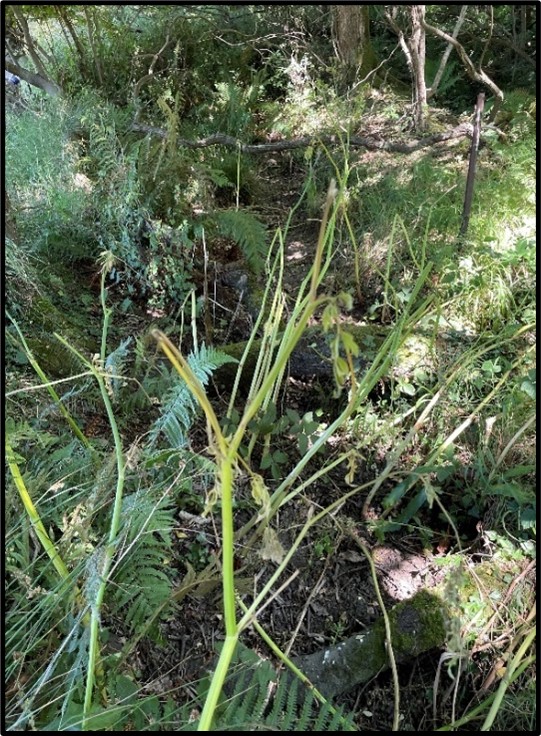
There is much to look forward to and many more exciting plans afoot. The black poplar, one of the rarest trees native to the UK, may make a comeback at Wild Woodbury. Rob mentioned reintroducing lost species, including the pine marten. We even asked about the possibility of bringing Bison to the area and (dare I write it) name one of them after Charles. Clearly, this would need some major feasibility work – and to see how it goes in Kent, where the animals have just been reintroduced. For now, a few ponies, cattle and pigs will be let loose to roam the site and support the evolving ecosystems.
I have found writing this note and thinking about nature strangely restorative. The visit to Dorset with Cedric even more so. I am proud to work for a company that has chosen to play its part in helping to restore nature.
I am of course aware of the irony that I was on plane contemplating the English countryside. While I offset my flight (and my colleague, Mark Rogers, went even further by getting the ferry back from Dublin to Wales), this goes to show the hypocrisy of our modern lives. Many of us want to do good, but sometimes, you have to get in your car. Sometimes, you have to get on a plane. The key, at least in my mind, is to be an active part of the transition to a more sustainable world: fly less; eat less meat; restore the countryside…and on and on.
A final thought from Isabella Tree, before two book recommendations. Get your kids involved in nature: “children who spent time in green spaces between the ages of seven and twelve tend to think of nature as magical. As adults they are the people most likely to be indignant about lack of nature protection, while those who have had no such experience tend to regard nature as hostile or irrelevant and are indifferent to its loss. By expurgating nature from children’s lives we are depriving the environment of its champions for the future.”
Books to read:
Isabella Tree, Wilding: The Return of Nature to a British Farm
Charles Clover, Rewilding the Sea: How to Save Our Oceans.
It seems nominative determinism is hard at work in the world of rewilding.
The views expressed in this article are those of the author at the date of publication and not necessarily those of Montanaro Asset Management Ltd. The information contained in this document is intended for the use of professional and institutional investors only. It is for background purposes only, is not to be relied upon by any recipient, and is subject to material updating, revision and amendment and no representation or warranty, express or implied, is made, and no liability whatsoever is accepted in relation thereto. This memorandum does not constitute investment advice, offer, invitation, solicitation, or recommendation to issue, acquire, sell or arrange any transaction in any securities. References to the outlook for markets are intended simply to help investors with their thinking about markets and the multiple possible outcomes. Investors should always consult their advisers before investing. The information and opinions contained in this article are subject to change without notice.
[1] With diverse members ranging from landowners and farmers to businesses, NGOs and communities, the Network is a powerful tool in catalysing rewilding. Through a combination of site visits, online webinars and networking opportunities, the Network encourages and guides people on their rewilding journey, helping them upscale and connect with each other. There is a real thirst for practical information and advice around rewilding. The collective evidence from these projects within the Rewilding Network supports key legislative and policy change that supports rewilding.


